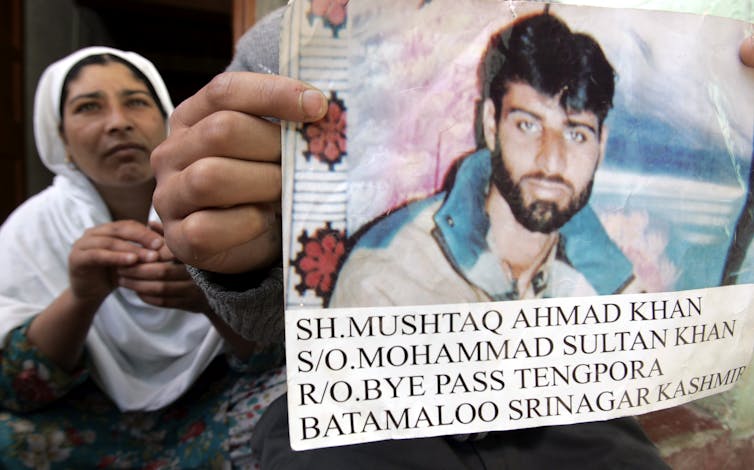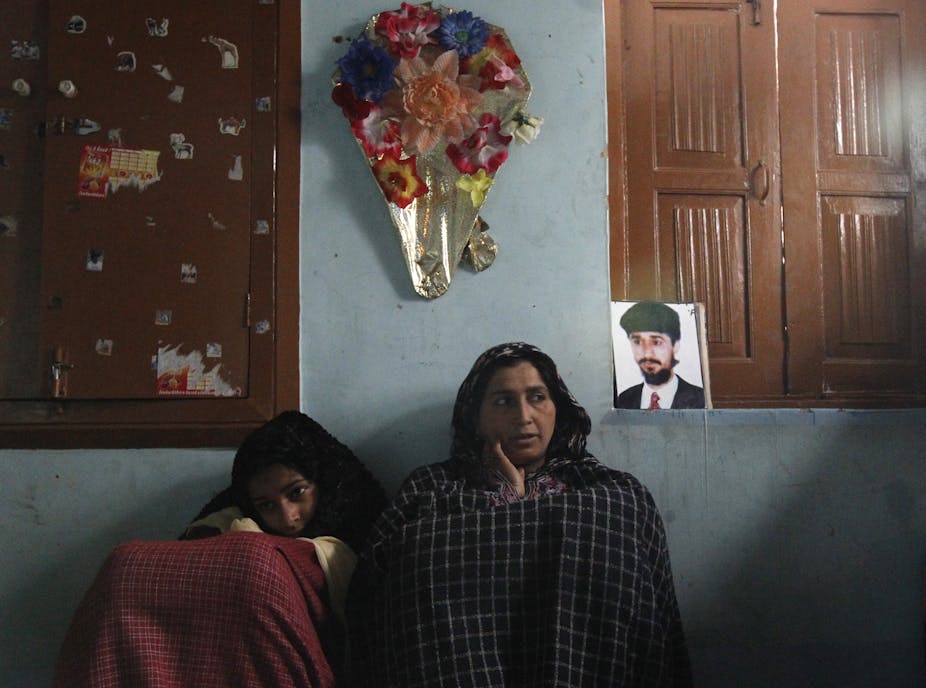Among the devastating effects of war is one that is often witnessed yet hard to truly quantify: hundreds of thousands of people go missing every year, never to be seen again by their loved ones. Family and friends are left in limbo, while wives live in poverty and despair as “half-widows”, not knowing whether their husbands are dead or alive.
Disappearances like these have long been a feature of the conflict in Kashmir. There is often no record of arrests, and some NGOs have alleged that torture is used as a state tool.
In 1947, the British Indian Empire was divided into the sovereign states of Pakistan and India. Due to its geographical location both countries “claimed” Kashmir, but it was generally assumed that it would accede to Pakistan as it had a majority Muslim population.

Three wars in 1965, 1971 and 1999, and a longstanding insurgency mean that the region remains disputed, with both nations, as well as China, controlling the territory. Kashmir is the most densely militarised region in the world with over half a million troops stationed there. The United Nations estimates that in the last 25 years 100,000 people have died and a further 8-10,000 individuals have “disappeared”.
Gendered violence
Those subjected to enforced disappearances tend to be men, but women are the unreported victims of war. As in many conflicts, the army and police have been accused of rape, sometimes to force compliance. The Kunan Poshspora incident is just one high profile example: in 1991, an estimated 40 women from two Kashmir villages were gang raped by members of the Indian army in just one night.
The Indian government has registered 1,336 cases of rape in Kashmir since 2006, but there have been few convictions. Official statistics on sexual violence are very conservative: 12% of interviewees who took part in a 2005 study by Médecins Sans Frontières reported that they had been victims of sexual violence since 1989.
At present, the number of half-widows remains unconfirmed: the Jammu and Kashmir Coalition of Civil Society (JCCS) estimates there are 1,500 half-widows while other estimates put the number closer to 2,500.
Half-widows face financial difficulties because they cannot access their husband’s property or bank accounts since death certificates are required for this. But these are not available since their husbands are not officially recognised as deceased. Under Muslim personal law, a person cannot be declared dead until seven years after their disappearance. There is government assistance but many would not want to accept this money as they see the state as responsible for their husband’s disappearance.
For those that do decide to apply for government support, this ex gratia relief is only available once more than seven years have passed since the husband went missing. The disappeared person also needs to be cleared of any militant-related activity. This should be relatively simple as Amnesty International and Human Rights Watch state that the disappeared are mainly farmers, students or skilled workers. However, the government often finds “evidence” that the individual is part of the insurgency.
Those who do manage to receive government assistance have reported corrupt practices with some officials asking for a percentage of the payment or sexual favours. If they do receive a payment, the women often live in poverty as the monies are shared or even seized by the paternal family, or the half-widow is forced to leave their marital home.
Life in limbo
Remarriage is considered a taboo and so many do not remarry in the hope that their husband will eventually return. Others decide against remarriage, often because they are concerned that a stepfather will not accept another man’s children.
Despite it being unlikely that they have links with the insurgency, half-widows report feeling that they are negatively associated with the violence. For those women who do want to remarry, the religious interpretations of the rules around remarriage when a person has disappeared had, up until recently, been contested. In 2014, a landmark decision reduced the waiting period for remarriage from seven to four years.
The Kashmir state government is taking important steps to support women by setting up empowerment programmes via women’s groups and non-governmental development organisations and Kashmiri women have themselves created self-help groups for victims of rape. Programmes have also started to tackle gendered violence experienced through political turmoil or domestic violence, as well as traditional practices such as sex-selective abortion and female infanticide.
Other women have become empowered by activism: a mother who got little support to find her missing son created the Association of Parents for Disappeared Persons, for example.
As the International Day of the Disappeared approaches, it is important for advocacy groups to raise awareness of the gendered nature of violence and the plight of Kashmir’s half-widows, so that these women are no longer forgotten.

